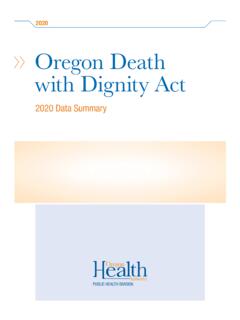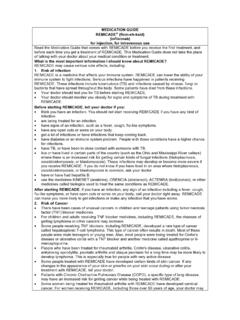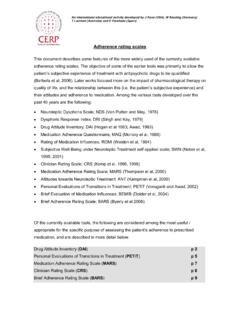Transcription of JAIL-BASED MEDICATION-ASSISTED TREATMENT P
1 JAIL-BASED MEDICATION-ASSISTED TREATMENT . PROMISING PRACTICES, GUIDELINES, AND RESOURCES FOR THE FIELD. October 2018. JAIL-BASED MEDICATION-ASSISTED TREATMENT : Promising Practices, Guidelines, and Resources for the Field 1. CONTENTS. Forewords .. 2. Acknowledgments .. 4. What's in It for Me as a Criminal Justice Executive? .. 5. Overview Best Practices and Guidelines for JAIL-BASED MEDICATION-ASSISTED TREATMENT .. 7. Best Practices and Guidelines for JAIL-BASED MEDICATION-ASSISTED TREATMENT .. 8. Client enrollment in a JAIL-BASED MAT program ..8. The correct medication , dosage, and length of TREATMENT determined for a client in MAT ..9. MAT for pregnant women .. 14. medication alone is not the answer: The force multiplier of partnerships and support services.
2 16. MAT program components: Assembling the right team, safeguards, protocols, and structure for a successful JAIL-BASED program .. 17. The importance of client screening to address TREATMENT continuation, withdrawal, and 21. Engaging Medicaid and postrelease financial assistance .. 23. JAIL-BASED MEDICATION-ASSISTED TREATMENT Programs in 25. Appendix I: Substance Use Disorder Screening Tools .. 30. Appendix II: Substance Use Disorder TREATMENT Programs .. 31. Appendix III: Advisory Roundtable Membership .. 32. 34. About the NSA and NCCHC .. inside back cover To find this resource online, visit To request MAT-related technical assistance, visit This project was supported by Contract Number DJBP0700 COBOSN511010, awarded by the National Institute of Corrections, and Grant Number 2016-MU- BX-K021, awarded by the Bureau of Justice Assistance.
3 The Bureau of Justice Assistance is a component of the Office of Justice Programs, which also includes the Bureau of Justice Statistics, the SMART Office, and the Office for Victims of Crime. Points of view or opinions in this document are those of the authors and do not represent the official position or policies of the United States Department of Justice. JAIL-BASED MEDICATION-ASSISTED TREATMENT : Promising Practices, Guidelines, and Resources for the Field 1. NATIONAL SHERIFFS' ASSOCIATION. FOREWORD. Jails have become a revolving door for individuals struggling with mental health and substance use disorders. More than 10 million individuals pass through jails around the country annually, with at least half of those individuals having substance use disorders, half of whom are opioid abusers.
4 Individuals suffering with mental health and substance use disorders come in and out of the jail , with arrests, incarceration, and release to the community, where the abuse restarts and the cycle continues when they commit another crime. Without effective intervention, this drives our nation's crime rate dramatically, while those who are most vulnerable remain sick. Jails not only oversee individuals struggling with substance use disorders and withdrawal, but are also in a unique position to initiate TREATMENT in a controlled, safe environment. Historically, it has not been the responsibility of the sheriffs and jail administrators to be primary providers of substance use disorder treatments.
5 But with thousands of Americans dying every week from drug overdoses and those recently released from jail among the most defenseless, the situation has changed sheriffs have taken on the challenge. In 2017, the nation's sheriffs resolved to support the most current, evidence- based substance use disorder TREATMENT within their jails to respond to the opioid and drug epidemic. Sheriffs have become this nation's pioneers in establishing MEDICATION-ASSISTED TREATMENT (MAT) programming, expanding jail MAT programs into 30 states at present. The following guidelines introduce what has been learned from the sheriffs' and jail administrators' innovative use of MAT, describing the essential components of these programs and analyzing the latest research on how these programs are best implemented, as well as the medications approved for opioid use disorders.
6 The guidelines are a result of the extraordinary collaboration of our federal, national, and private partners. Our nation's sheriffs and jail administrators are deeply appreciative for their contributions and commitment to assisting the jails in addressing the opioid epidemic for our justice-involved populations. Jails represent perhaps the most unique place to get individuals off drugs and on the path to long-term recovery. But jails can only help individuals begin that journey communities must shepherd those in need through that journey. As illustrated by the examples of several successful jail programs captured in the guidelines, the sheriffs and jail administrators reach beyond the walls of their jails to collaborate with TREATMENT and support services in the community to ensure that what has begun in jail continues upon release.
7 We hope that sheriffs and jail administrators will find the Promising Practices, Guidelines, and Resources helpful in making these programs available to those who so desperately need them for their health and well-being as well as the safety of our communities. Jonathan F. Thompson Executive Director and CEO. National Sheriffs' Association 2 JAIL-BASED MEDICATION-ASSISTED TREATMENT : Promising Practices, Guidelines, and Resources for the Field NATIONAL COMMISSION ON CORRECTIONAL HEALTH CARE. FOREWORD. As my colleague Jonathan Thompson notes, jails are on the front lines of the opioid epidemic in the United States. over the past 40 years, sheriffs and jail administrators across the country have sought to improve the quality of health services provided to the individuals in their care.
8 In the mid- 1970s, 30 jails served as the pilot sites for the first health services standards for correctional settings and an accompanying accreditation program. Today, the National Commission on Correctional Health Care (NCCHC) continues to help jails address the most complex problems in health services, including care for individuals suffering from mental illness and substance use disorder. In addition to its standards for jail health services, NCCHC also offers standards and accreditation specifically for opioid TREATMENT programs. As this publication makes clear, pharmacotherapy , MEDICATION-ASSISTED TREATMENT (MAT) is widely held to be a cornerstone of best practice for recovery from substance abuse.
9 Effective TREATMENT , including MAT, particularly when coupled with evidence- based behavioral TREATMENT , improves medical and mental health outcomes and reduces relapses and recidivism. MAT provides a significant opportunity to help individuals with substance use disorder, especially those who participate in a community- based opioid TREATMENT program (OTP). OTPs are licensed facilities that provide methadone and often other MATs for individuals diagnosed with an opioid-use disorder. Effective TREATMENT for substance use disorder, including long-term MAT, has been shown to reduce drug use, overdose, and mortality. Fundamentally, it is key to halting the national epidemic of drug abuse, particularly opioid use disorder, and interrupting the costly cycle of recidivism resulting from this underlying disorder.
10 We encourage sheriffs and our JAIL-BASED colleagues to take the lead in this effort. James R. Pavletich, MHA, CAE, CCHP. Chief Executive Officer National Commission on Correctional Health Care JAIL-BASED MEDICATION-ASSISTED TREATMENT : Promising Practices, Guidelines, and Resources for the Field 3. ACKNOWLEDGMENTS. So many people and organizations made the document Through his thoughtful engagement and input of the project JAIL-BASED MEDICATION-ASSISTED TREATMENT : Promising Practices, partners, Dr. Klein brought to life a document that will be of Guidelines, and Resources for the Field possible. Although significant service to the field. In addition, special recognition it is not feasible to recognize each of these contributions goes to Jennie M.










